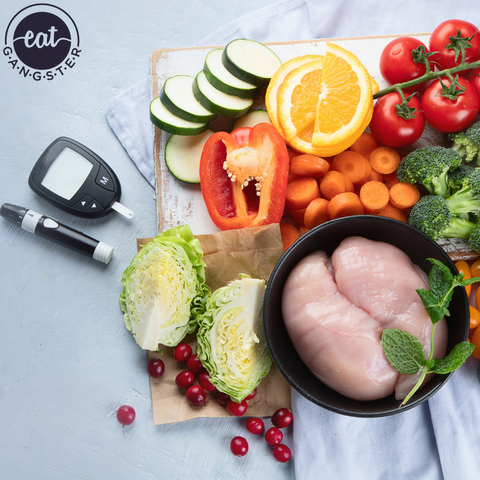
Starting an elimination diet can be TOTALLY overwhelming for some folks. When you feel like the rug has been pulled out from under you and all your go-to meals and snacks are no longer on the menu, it can feel daunting, frustrating, and a little depressing. As someone who has been through many bouts of experimentation with elimination diets, I am here to tell you that there is nothing more valuable than this practice for determining what works for your body and what doesn’t. Blood tests can be fickle and EXPENSIVE, and only YOU know how you feel and what symptoms you experience after eating certain foods. It takes patience and determination, but it’s a worthy experiment to eliminate commonly triggering foods and slowly bring them back into the fold, one by one. Your body will tell you. Symptoms are powerful messengers, and it’s wise to listen to them.
Autoimmune disease is birthed from a leaky gut, which means that the lining of the gut is damaged, or permeable, allowing some poorly digested protein molecules to leak into the bloodstream. This often triggers an immune response—your body recognizes these particles as foreign invaders and launches an attack. Your immune system, doing its job, then creates antibodies against this “foreign invader” and now every time you eat that food, your body has an immune response. This can be as minor as drainage down the back of your throat or as major as joint inflammation.
The AIP diet was designed to eliminate commonly triggering foods and bring them back in one by one to see for sure which ones are contributing to your symptoms or worsening your autoimmune condition. Foods to eliminate:
- Dairy
- Eggs
- Nuts
- Seeds
- Grains
- Gluten
- Coffee
- Chocolate
- Legumes
It’s a modified, or further restrictive Paleo diet, really. And it’s temporary, which is the good news! Removing some inflammatory foods from your diet can improve not only some of your pesky symptoms, but you might also end up with better sleep, less brain fog, more energy, less anxiety—worth a try, right?
Although it’s easiest to follow AIP blogs, cookbooks, search recipes that are specifically AIP compliant, and of course indulge in eat G.A.N.G.S.T.E.R.baking mixes, here are some basic substitution ideas to try when modifying basic recipes you love.
Dairy

Oh, the creaminess of dairy! We were biologically trained to want milk—our mother’s milk. I think we’re the only species that weans from our mother’s milk and then starts drinking the milk of another species, but that’s for another blog post. Dairy is such a staple in the Standard American Diet, and SO many of us either can’t tolerate the proteins or the lactose in dairy. Almond milk became wildly popular over a decade ago, and since then, we can find every variety of nut milk, seed milk, oat milk…the list goes on, and unfortunately, nuts, seeds and grains are not AIP compliant. So, what are your options?
Coconut Milk to the rescue—substitute full fat or light coconut milk for milk or cream adjusting the thickness as needed. Milk is obviously thinner than cream, so emulsify a can that’s separated for cream or sour cream substitutes. You can make ice cream, ranch dressing, and all kinds of favorites with full fat coconut milk from a can. Look for brands without gums or emulsifiers if you can, like Native Forest. Missing yogurt or need a good substitute for a recipe? Culina is a brand that is absolutely delicious and AIP compliant!

Avocado—the fruit that’s an incredible source of healthy monounsaturated fat, fiber and protein! If you need your creamy fix, the avocado can do the trick! Search pudding recipes—I like to blend a mango and an avocado for a dreamy, creamy, decadent treat!

Eggs

Eggs are really a baker’s friend. They can act as a binder, a leavening agent or a moisturizer. They add protein and body to baked goods as well. A typical substitute would be a “flax egg” or a “chia egg” but both being seeds, neither will work for an AIP diet. This can be a tricky category for substitutions. If the egg is serving as a binder or moisturizer, try mashed banana, applesauce or squash/sweet potato puree. Banana and applesauce provide moisture and sweetness, which can be a real win, and squash/sweet potato can provide extra fiber and nutrition to baked goods. You can decide which is best for the recipe. If there isn’t any baking soda or baking powder in the recipe, that usually means the egg is acting as the leavening agent. In AIP baking, it can be helpful to add baking soda and apple cider vinegar in a one to two ratio (1/2 t. baking soda, 1 t. ACV). This creates some rise while staying compliant.

Flour

Oh, all-purpose flour…you’re so versatile and cheap and make such flaky, delicious baked goods. And there’s the low-carb almond flour that makes baked goods delicious AND perfectly paleo. Oat flour and brown rice flour are also delicious, but none of the aforementioned flours are AIP compliant, so what do we do?
The four flours we use here at eat G.A.N.G.S.T.E.R. are:
Cassava flour—comes from the yuca or cassava root, perfectly starchy and works well in baked goods
Tiger nut flour—Tiger Nuts are not nuts at all! They are tiny little tubers, high in resistant starch (prebiotic fiber!), naturally sweet, and a great sub for most flours.
Tapioca flour—also a derivative of the cassava plant, tapioca flour (or starch) when added to tigernut flour makes a nice all-purpose flour for baked goods.
Coconut flour—high in fiber and light in color, this flour is great in combination with one or all of the above. It tends to absorb moisture, so you may have to add a bit more liquid to a recipe with coconut flour.

Chocolate

Can one live without chocolate? Temporarily, yes, and if it really causes problems for you, you may want to cut it out permanently. Our number one sub is carob, which you can buy in powder form and use in recipes that call for cocoa powder. Carob is actually a legume, which is not allowed on AIP, but carob powder is made only from the pod and not the bean itself!

Coffee
Giving up chocolate can be hard, but wow—folks can get a little crazy when asked to give up coffee even for a few weeks. It’s the caffeine, I know, but it’s also the ritual for most people, and it definitely is for me. There are alternatives that I promise you can live with. Matcha gives me a natural energy boost without the jitters, and when it’s made into a latté with coconut milk, it’s creamy and SO satisfying. Matcha has some pretty amazing health benefits, including anti-cancer compounds! For another morning beverage with benefits, check out my friend, Alison’s (Food by Mars) recipe for Cinnamon Vanilla Cordyceps Latté. Make sure to note the adaptations for AIP!

If you are embarking on an AIP adventure, I applaud you for taking this step. And, remember, eat G.A.N.G.S.T.E.R. has your back with our cookie mixes, cake mixes and banana bread mix. Follow us @eatgangster.
Heather McDonough, NTP
Co-founder



